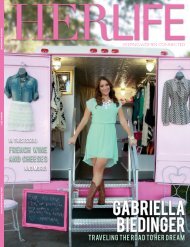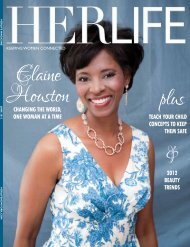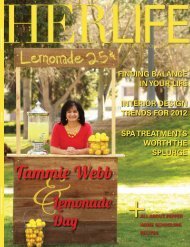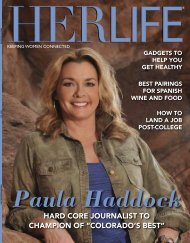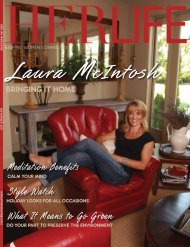CLARK STACIE CLARK STACIE - HER LIFE Magazine
CLARK STACIE CLARK STACIE - HER LIFE Magazine
CLARK STACIE CLARK STACIE - HER LIFE Magazine
- No tags were found...
You also want an ePaper? Increase the reach of your titles
YUMPU automatically turns print PDFs into web optimized ePapers that Google loves.
herlife | mother’s perspectiveCutting the Apron StringsHow to Raise Happy, Healthy, Independent Kidsby chandra blackwellIf you’re a parent, you know what it’s liketo wish for more sleep, more time andsometimes more patience. But one thinga parent hardly ever has to wish for is moreadvice...or criticism. Turn one direction andoverprotective (a.k.a. “helicopter”) parents arebeing criticized for shielding their childrenfrom even the most minor difficulty or discomfortand creating, in some minds, a nationof wimps. Turn the other way, and mouthsstand agape at the concept of free-range kids,a term coined and popularized by (in)famousmom Lenore Skenazy, who allowed her nineyear-oldson to navigate the New York subwaysystem alone. No matter where you fall onWhere isthe happymedium?the spectrum, you may be wondering: whereis the happy medium? How can you cut theapron strings in a timely and appropriate way,so that your kids grow up happy, healthy,and confident—but also safe? The truth isthat most kids grow up way too quickly for aparent’s comfort, but with a little effort andsome deep breathing, you can support yourkids without “hovering,” and encourage theirindependence and self-reliance without leavingthem to the wolves.Toddlers (1-4)Resist the Urge to RescueAs parents, we have a built-in protectiveinstinct that can make it difficult not toswoop in and save the day when we seeour children struggling. And sometimes,of course, that’s appropriate; ifyour toddler’s shoelace gets caughtin a sewer grate and there’s agarbage truck coming, it’s probablybest to do what it takesto get him out of the street(and out of harm’s way) asquickly as possible. However,if he’s merely struggling toput his pajamas on byhimself, it’s okay tooffer encouragementfrom the sidelineswhile he figures itout on his own,even if he gets alittle frustrated. Itmay quite literallyrequire sitting onyour own hands to do it, but encouraginga toddler to work out his own dilemma canhelp him begin to develop a healthy sense ofself-reliance.Big Kids (5-8)Decisions, DecisionsEven as adults, we depend on others;very few of us, for example, produce all of ourown food, manufacture our own vehicles orcut our own hair (more than once, anyway).So of course, your child will continue to dependon you to meet certain basic needs, suchas keeping her fed and getting her to the doctorand to soccer games. However, at this stageof her development, she should not be tooreliant on others for making basic decisions;while she may rely on you to provide adviceor perspective, she should be making her ownchoices in many situations. As a parent, youcan encourage more independence in your“big kid” by allowing her to make simple,everyday decisions on her own: which clothesto wear (you can intervene to make sure she’sdressed appropriately for the weather, but mayhave to turn a blind eye to some aestheticchoices), what to order in a restaurant orwhich of Kafka’s works best speaks to theexistential dilemma. What’s important hereis that she’s becoming more confident usingher own judgment as she moves toward moreindependence.Pre-teens (8-12)Talk About ItAt this stage, your child’s worldview–andsphere of influence–has expanded well be-34 <strong>HER</strong><strong>LIFE</strong>MAGAZINE.COM



